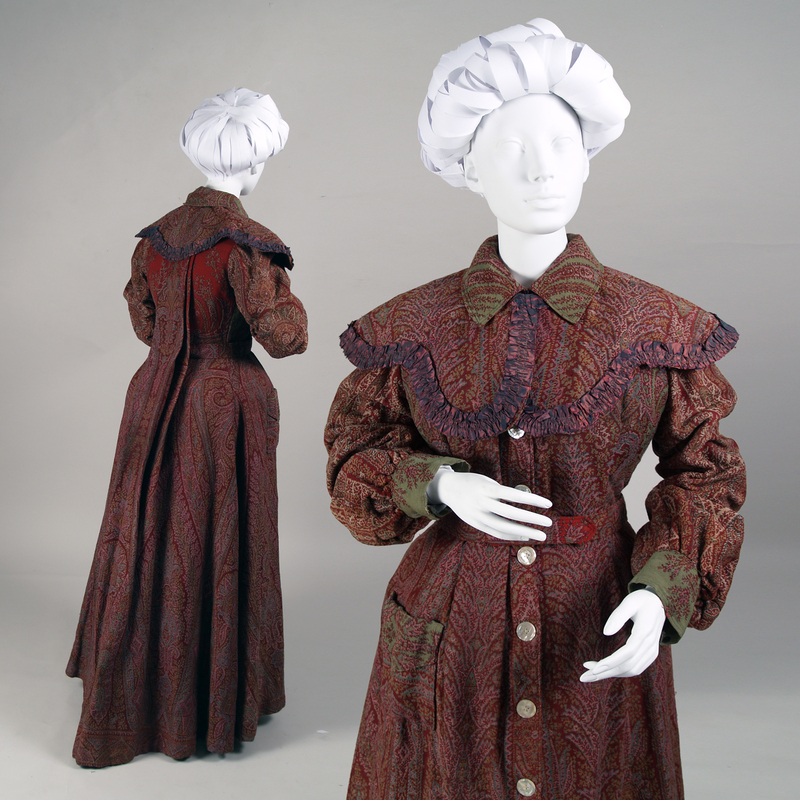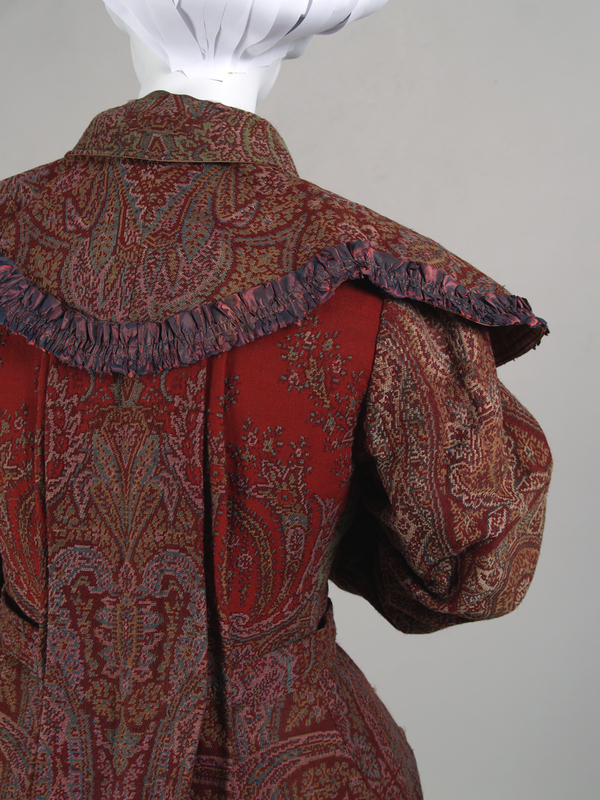Tea Gown
Item
-
Title
-
Tea Gown
-
Description
-
The maker and place of origin of this tea gown are unknown but it was created from a European shawl, likely circa 1891. The gown is pictured at two angles on a white mannequin with a white paper headpiece; the back and front are showcased. Intricate vegetal and paisley patterns on different colour fields adorn the wool fabric. The gown is visually striking with a straight collar closed at the neck, a detachable shoulder cape trimmed in purple silk, fashionable full sleeves with cuffs, a fabric belt, and, over the belt in back, a series of box pleats from neck to floor called “Watteau pleats.” The collar, right hip pocket, and cuffs are cut from shawl sections with an olive field, while the belt and back bodice are cut from sections with a brighter shade of red than the rest of the gown, which is predominantly burgundy. The gown closes at centre front with mother-of-pearl buttons. The pleated back structure provides volume at the skirt but, unlike the eighteen-century style for which Watteau pleats are named, pleats are stitched down at the upper bodice to help delineate a corseted figure.
-
ANNE BISSONNETTE ON WHAT THIS OBJECT TEACHES US:
Dr. Bissonnette studies the unique appeal of tea gowns. While all tea gowns were interior gowns, not all interior gowns were fit to be worn by a hostess when receiving guests for five o’clock tea. This wool gown would be very comfortable in a home without central heating yet, being expertly cut and belted to emphasize the corseted Victorian figure, it was proper attire to receive guests for tea.
The wool fabric was cut from an elaborate shawl likely produced in Scotland. Dr. Bissonnette notes that the pattern was intended to imitate Kashmiri archetypes. She explains that design exchanges between Kashmir and Europe were common during the nineteenth century and resulted in innovative styles. Scottish machine-made shawls that mimicked Kashmiri designs were a source of great pride because they evidenced technological advancements. “Four-seasons” shawls, like one from the Metropolitan Museum of Art's collection, could be folded strategically to highlight different colour fields when worn. By the end of the nineteenth century, some shawls were cut and repurposed as tea gowns, which could be quite whimsical.
According to Dr. Bissonnette, tea gowns emerged from the broader category of elaborate interior gowns and were often worn in front parlours. They spoke of the comfort of home but home could be a very public space where a wide array of guests were entertained. She explains that, with its loose-looking Watteau pleats, the gown navigated the fine line between the unfitted styles worn in private quarters and the fitted styles worn in public quarters of the home, like the front parlour. The patterns of the gown shown here also blended well with the exotic decorations found in fashionable front parlours that conveyed to visitors their hostess’s artistic sensibilities.
Tea gowns were firmly rooted in Victorian aesthetics and possessed special significance in the complex system of sociability that emerged in the latter half of the nineteenth century. Dr. Bissonnette describes how increased urbanization gave rise to new codes of behaviour and dress to establish order in a rapidly expanding bourgeois culture throughout the Western world. Tea gowns were part of these new codes, which were disseminated through etiquette manuals and ladies’ periodicals that proliferated at this time. With popular features like Watteau pleats, the use of foreign aesthetics like paisley patterns, and the mixing of many unrelated elements, the tea gown spoke of the historicism, exoticism, and eclecticism of the late-Victorian period.
Dr. Bissonnette argues that many social, political, and historical forces are embedded in this specific object. The label “tea gown” emerged in England during the expansion of British colonial rule in India, which helped democratize tea drinking in England and had a lasting influence on British commerce and identity. As teatime’s popularity increased, so did the tea gown’s use. They evolved from “formal undress” worn at home to acceptable day and evening wear outside the home, offering respectable women a means to experiment within codified nineteenth-century sociability and dress.



